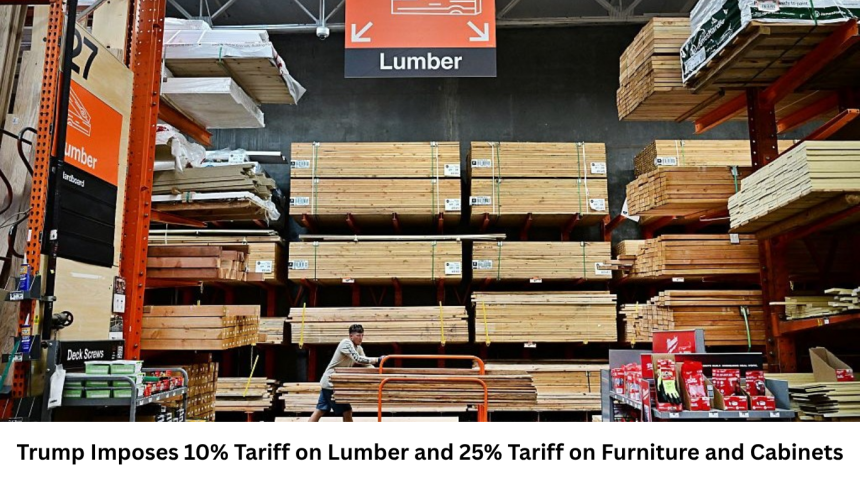Former US President Donald Trump has announced the introduction of new tariffs aimed at boosting domestic manufacturing and reducing reliance on foreign imports. The new policy places a 10 percent tariff on lumber and a 25 percent tariff on furniture and cabinets imported into the United States. The move is part of a broader effort to strengthen American industries, protect local jobs, and balance trade relations with key exporting countries.
- Background of the Tariff Decision
- The Political and Economic Context
- Why Lumber and Furniture Were Targeted
- Goals of the New Tariffs
- Reactions from the Lumber Industry
- Reactions from the Furniture and Cabinet Industry
- Impact on the Construction and Housing Markets
- International Reaction and Trade Relations
- Consumer Reactions and Market Expectations
- Potential Benefits of the Tariffs
- Potential Drawbacks and Criticisms
- The Role of Domestic Manufacturing
- Economic Outlook
- Historical Context of US Trade Tariffs
- Frequently Asked Questions
- Conclusion
While supporters view the tariffs as a step toward revitalizing American manufacturing, critics warn that the decision could increase costs for builders, retailers, and consumers. The policy is expected to affect multiple sectors, including construction, home furnishing, and international trade relations.
This article explains the reasons behind the new tariffs, their potential economic impact, reactions from industry experts, and what this means for American businesses and households.
Background of the Tariff Decision
Tariffs are taxes imposed by a government on imported goods. They are often used to protect domestic industries from foreign competition or to encourage local production. In this case, the Trump administration’s new tariffs are focused on two major import categories: lumber and finished furniture products, including cabinets.
For years, the United States has relied heavily on imported wood and furniture materials, particularly from Canada, China, and Southeast Asian nations. This reliance has raised concerns among policymakers who argue that domestic producers are being undercut by cheaper foreign goods.
The 10 percent tariff on lumber is designed to give US timber producers a competitive advantage, while the 25 percent tariff on furniture and cabinets aims to strengthen local furniture manufacturers who have faced intense price competition from imported products.
The Political and Economic Context
The announcement of these tariffs comes amid ongoing discussions about the state of American manufacturing and trade imbalances. Trump has long been a vocal advocate of protectionist trade policies, emphasizing the need to bring back jobs that have been lost to globalization and outsourcing.
During his previous administration, Trump imposed tariffs on steel, aluminum, and a range of goods from China, arguing that such actions were necessary to ensure fair trade. His supporters believe that these measures helped protect American industries and promoted economic independence.
The new round of tariffs continues that theme, targeting sectors that have seen significant foreign competition in recent years. The goal is to encourage businesses to invest more in domestic production and create jobs for American workers.
Why Lumber and Furniture Were Targeted
The choice to impose tariffs on lumber, furniture, and cabinets is not random. These industries have been at the center of debates about trade, domestic production, and economic fairness.
Lumber plays a critical role in the housing and construction industries. Many homebuilders in the United States rely on imported wood, especially from Canada, because it is often cheaper and readily available. However, domestic producers have complained for years that imported lumber is unfairly priced due to subsidies and trade practices abroad.
Similarly, the furniture and cabinetry sectors have been hit hard by global competition. Over the past two decades, many American furniture factories have closed or relocated overseas, particularly to China and Vietnam, where labor and production costs are lower. The 25 percent tariff is intended to make imported furniture more expensive, giving local manufacturers a chance to compete on a level playing field.
Goals of the New Tariffs
The Trump administration has outlined several goals for these new tariffs. The main objectives include boosting American manufacturing, reducing the country’s trade deficit, and ensuring fair competition between domestic and foreign producers.
Supporters argue that by making imported goods more expensive, consumers and businesses will be encouraged to buy American-made products. This could help revitalize struggling industries and create more jobs within the country.
Another goal is to push foreign producers to negotiate better trade terms. Tariffs can be used as a tool to pressure trading partners into agreeing to more balanced trade agreements that benefit the United States.
In short, the new tariffs are intended not only to protect local industries but also to strengthen America’s long-term economic independence.
Reactions from the Lumber Industry
Reactions to the 10 percent tariff on lumber have been mixed. Domestic lumber producers largely welcomed the announcement, saying it would help level the playing field and protect American jobs in forestry and sawmills.
Many American timber companies have struggled to compete with cheaper imports from Canada, which is the largest foreign supplier of softwood lumber to the US market. Canadian wood is often sold at lower prices due to government subsidies and other trade advantages.
By imposing a 10 percent tariff, the US hopes to make domestic lumber more competitive. Industry representatives say this will lead to increased investment in American forests and mills, potentially creating thousands of new jobs in rural communities.
However, homebuilders and construction companies have expressed concern that the tariffs could increase the cost of building materials, which in turn could drive up housing prices.
Reactions from the Furniture and Cabinet Industry
The furniture and cabinetry industries have faced significant challenges from international competition for many years. Imports from China, Vietnam, and Malaysia have dominated the US market due to their lower costs and mass production capabilities.
Domestic manufacturers have praised the 25 percent tariff, arguing that it could help revive the American furniture industry, which has seen a steady decline since the early 2000s. Many believe this policy will make it more profitable to manufacture products locally, leading to job growth in states such as North Carolina, Mississippi, and Michigan, where furniture production once thrived.
However, some business owners worry about potential short-term disruptions. Retailers that depend on imported furniture for their supply chains may face higher costs, which could eventually be passed on to consumers.
Despite these concerns, many industry experts agree that the tariffs could encourage long-term investment in US-based manufacturing and reduce dependency on overseas suppliers.
Impact on the Construction and Housing Markets
One of the most immediate effects of the 10 percent lumber tariff is expected to be felt in the housing and construction sectors. Lumber is a key material in homebuilding, and price increases can have a ripple effect throughout the market.
Builders have warned that even a small increase in lumber costs can translate to thousands of dollars added to the price of a new home. This could make housing less affordable, particularly for first-time buyers and middle-income families.
At the same time, the tariffs could stimulate more domestic lumber production, which may eventually stabilize prices over the long term. Industry analysts believe that if domestic mills can ramp up output efficiently, the initial cost increases could be offset by a stronger and more self-sufficient supply chain.
International Reaction and Trade Relations
The new tariffs are expected to strain trade relations with some of the United States’ key trading partners. Canada, in particular, may challenge the decision, as it has done in the past over similar softwood lumber disputes.
China, Vietnam, and other Asian exporters of furniture and cabinetry may also respond with criticism or retaliatory trade measures. These countries have become major suppliers to the US market, and any reduction in their export volumes could impact their economies.
International trade experts warn that tariffs can lead to escalation if affected nations decide to impose their own taxes on American exports. Such trade tensions could disrupt global supply chains and increase costs for businesses on both sides.
Consumer Reactions and Market Expectations
From a consumer standpoint, the new tariffs may have mixed consequences. While some consumers may support the idea of protecting American jobs, many could face higher prices for home goods, furniture, and housing materials.
Retailers are expected to adjust their pricing strategies in response to increased import costs. Some may shift to sourcing from domestic producers, while others might absorb the extra costs temporarily to maintain competitiveness.
In the short term, shoppers could see noticeable price increases on imported furniture and cabinetry. Over time, however, the development of stronger local manufacturing could lead to a more stable and self-reliant market.
Potential Benefits of the Tariffs
Supporters of the new tariffs believe that the long-term benefits will outweigh the short-term challenges. They argue that the policy will:
-
Encourage investment in domestic industries
-
Protect jobs in manufacturing, forestry, and related sectors
-
Reduce dependence on foreign supply chains
-
Strengthen the US economy against external shocks
By supporting American businesses, the tariffs could foster innovation and quality improvements in locally made products. Some also believe the policy could inspire a wave of small business growth as entrepreneurs take advantage of the renewed demand for American-made goods.
Potential Drawbacks and Criticisms
Critics, however, caution that tariffs often lead to unintended consequences. One major concern is that higher import costs could lead to inflation in the housing and furniture markets.
Consumers may end up paying more for homes, furniture, and renovation materials, which could slow down spending and affect overall economic growth.
There are also concerns that the policy might provoke retaliatory measures from other countries, creating broader trade conflicts. Economists have also warned that domestic producers could take advantage of reduced competition by keeping prices high, reducing the intended benefits for consumers.
Overall, while tariffs can provide short-term protection, their long-term effects depend heavily on how industries and trading partners respond.
The Role of Domestic Manufacturing
A central goal of the tariffs is to encourage a revival of American manufacturing. Over the past few decades, many US factories have closed or moved overseas to take advantage of cheaper labor and production costs.
By making imported goods more expensive, the new tariffs create an incentive for businesses to reopen or expand manufacturing operations within the United States.
This could lead to new job opportunities and economic growth in regions that have been struggling with industrial decline. However, for these benefits to be sustainable, domestic industries must invest in modern technology, skilled labor, and efficient production methods.
Economic Outlook
Economists are divided on how the new tariffs will affect the overall economy. Some believe the policy will boost GDP growth by stimulating local production and reducing imports. Others worry that rising prices and potential trade conflicts could offset these gains.
In the short term, some inflationary pressure is expected, especially in sectors directly affected by the tariffs. However, if the strategy succeeds in building a stronger domestic base, it could enhance the long-term resilience of the US economy.
Ultimately, much will depend on how quickly American industries adapt and how other countries respond to the trade measures.
Historical Context of US Trade Tariffs
The United States has a long history of using tariffs to protect domestic industries. From the 19th century through the early 20th century, tariffs were a major source of government revenue and economic protection.
In modern times, tariffs have been used more strategically to address trade imbalances and unfair practices. Trump’s earlier trade policies, particularly against China, followed this tradition.
The latest move on lumber and furniture fits into this broader pattern of economic nationalism—an approach that prioritizes American production and job creation over global integration.
Frequently Asked Questions
Why did Trump impose tariffs on lumber, furniture, and cabinets?
The tariffs are intended to protect American industries, reduce trade deficits, and encourage domestic manufacturing by making imported goods more expensive.
What are the specific tariff rates?
A 10 percent tariff applies to lumber imports, while a 25 percent tariff has been placed on imported furniture and cabinets.
How will these tariffs affect housing prices?
Since lumber is a key building material, tariffs may increase construction costs, potentially making new homes more expensive.
How will consumers be affected?
Consumers could see higher prices on imported furniture and home products, though long-term benefits may include stronger domestic manufacturing.
Which countries are most affected by these tariffs?
Canada, China, and Vietnam are expected to be most affected, as they are major exporters of lumber and furniture to the United States.
Will these tariffs create American jobs?
Supporters believe they will create jobs in manufacturing and forestry, but the overall effect depends on how industries adjust to new conditions.
Could these tariffs lead to trade disputes?
Yes. Trading partners may challenge the tariffs or respond with retaliatory measures on American exports.
How long will the tariffs remain in place?
The duration of the tariffs depends on future trade negotiations and economic outcomes. They may be adjusted or lifted if goals are achieved.
Are tariffs a common tool in US trade policy?
Yes. The United States has used tariffs historically to protect industries and balance trade relations, especially during periods of economic uncertainty.
Will domestic producers benefit immediately?
Some may see quick benefits, but others will need time to ramp up production and meet demand. The full impact will unfold over the coming months.
Conclusion
The new tariffs on lumber, furniture, and cabinets represent a significant move in the ongoing effort to reshape America’s trade and manufacturing landscape. By imposing a 10 percent tariff on lumber and a 25 percent tariff on furniture and cabinets, the Trump administration aims to strengthen domestic industries, protect jobs, and reduce dependency on foreign imports.
While the decision has received both praise and criticism, it underscores a broader shift toward prioritizing self-reliance and fair trade. The coming months will reveal whether these tariffs can achieve their intended goals without triggering inflation or trade disputes.
For now, one thing is certain: the conversation about balancing global trade with national economic interests is far from over.




















